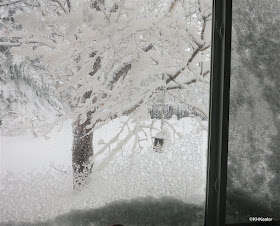Happy New Year! 2020.
I decided to make 2020 "the Year of 2020 Vision," reviewing my activities and all my stuff, asking if each is an active interest or something I think I might, maybe, do or use, sometime in the future. My possessions and surroundings should reflect my current self. The trick will be honest answers.
When I dial up 2020 Vision beyond the junk drawer, looking at my yard I find lots of ideas that I have carried over for years, to dust off and reconsider.
My current plan for the yard is to grow ever more native plants since my county is rapidly developing, turning native plant (and animal) habitat into malls and subdivisions. The natives need help! But much of my yard is standard garden plants and I like them too.
 |
| Yard corner: iris, lilacs, roses, English ivy - all from Eurasia |
 |
| periwinkle, Vinca |
I don't have an answer today. I am not going to kill the trees I nurtured.
Another observation that I am currently thinking hard about is how human-dominated our world is today. The plants in my yard are there because I put them there or at very best, did not remove them. So cutting down established trees would be more human intervention. In my dreams, the plants in my yard move around on their own, like the insects do. That produces its own issues. I am not going for the weedy vacant lot look. This year I am trying to direct wandering plants by leaving unplanted flower beds for seeds to fall into. My ecological training says that an unplanted flower bed in deep shade will welcome different seeds and seedlings than one in full sun, so it won't be total chaos. I'll have to weed out non-native invaders--human control again, alas. But the seeds of invaders from Eurasia like bindweed (Convolvulus arvensis), mullein (Verbascum thapsus), and dandelion (Taraxacum officinale) can survive decades in the soil, so unexpected weeds will appear for decades, no matter how many I remove.
"I like plants" makes another problem for my goal to grow natives. There are many nonnatives I'd like to grow, to see what they are like. For example, peanuts (Arachis hypogaea). My parents grew them one year in New York: it was quite a surprise to a child to see that they grow underground, not on a tree like a walnut. I still think that's cool and I'd like to grow them again. Or borage (Borago officinalis) and dill (Anethum graveolens). I have grown them in the past but do not have them now. They are useful (European) herbs, pretty plants, and attractive to pollinators.
 |
| borage, Borago officinalis |
 |
| Goji berry seedlings, Lycium chinese |
Happy New Year!
Comments and corrections welcome.
Kathy Keeler, A Wandering Botanist
More at awanderingbotanist.com

No comments:
Post a Comment